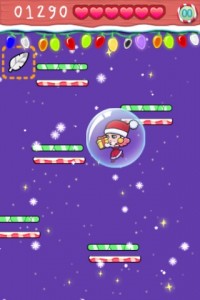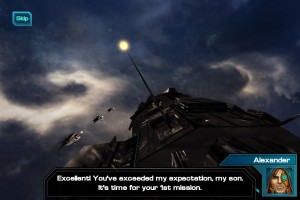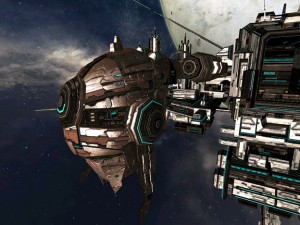 Your debut title, Daisy Doesn’t Jump, seems pretty typical for a new studio just getting into the App Store: 2D, a cute aesthetic, and a simple gameplay concept. Now here you are, unleashing a massive sci-fi Action RPG with some of the most gorgeous visuals we’ve seen on this platform, tons of different starships to customize, the works. There’s got to be an interesting story behind the transition from Daisy Doesn’t Jump to Galaxy Pirate Adventure! How did you manage to scale up to a production this large, given a year’s time?
Your debut title, Daisy Doesn’t Jump, seems pretty typical for a new studio just getting into the App Store: 2D, a cute aesthetic, and a simple gameplay concept. Now here you are, unleashing a massive sci-fi Action RPG with some of the most gorgeous visuals we’ve seen on this platform, tons of different starships to customize, the works. There’s got to be an interesting story behind the transition from Daisy Doesn’t Jump to Galaxy Pirate Adventure! How did you manage to scale up to a production this large, given a year’s time?
 Yes, if you look at our portfolio, that looks like quite a change of direction from Daisy Doesn’t Jump (Daisy) to Galaxy Pirate Adventure (GPA). But to us, the shift to a much bigger project in GPA was just the execution of a planned strategy. Here at Sunfish Studio, everyone on the team has been a long time gamer. We always wanted to do something big, but after careful consideration we decided to start with something small and manageable, and that’s why we started with Daisy.
Yes, if you look at our portfolio, that looks like quite a change of direction from Daisy Doesn’t Jump (Daisy) to Galaxy Pirate Adventure (GPA). But to us, the shift to a much bigger project in GPA was just the execution of a planned strategy. Here at Sunfish Studio, everyone on the team has been a long time gamer. We always wanted to do something big, but after careful consideration we decided to start with something small and manageable, and that’s why we started with Daisy.
Daisy, to us, was really a training program. We needed a real life project to experiment with and experience our own way of game making. We invested in this training to build up our team dynamics and to test drive our workflow, communication and decision making processes. In the end we spent a few weeks to complete the first version of Daisy, and later we also spent another couple of weeks to release a Christmas themed update.
GPA marks our first serious entry into the gaming industry. In GPA we aim to create a world-class Action RPG title. Though it’s of a totally different scale, our experience in Daisy did help the whole team to get better aligned. The team as a whole had also improved in all areas. While we remained a relatively small development team we’ve been able to keep our workflow smooth, our communications efficient, and our flexibility and creativity high. That’s really what differentiates us from the big players out there. Throughout our development schedule we’ve put a strong focus on getting the perfect balance among gameplay, artistic and technical aspects of the project. But when it comes down to hands-on development, there is really no magic, but just hard working. We worked seven days a week for nine months to reach this stage. When we look back, it’s all driven by our love of gaming.
 What can you tell us about the Galaxy Pirate King, and where he and the main character fit into the game world? Is the hero’s father a romantic Robin Hood-like figure, or is he the cutthroat kind of pirate we don’t normally want to run into?
What can you tell us about the Galaxy Pirate King, and where he and the main character fit into the game world? Is the hero’s father a romantic Robin Hood-like figure, or is he the cutthroat kind of pirate we don’t normally want to run into?
It’d be better for players to explore the Galaxy world and find the secret of the Galaxy Pirate King for themselves. As the story unfolds they might get a bit of a surprise!
Does the Sunfish Studio team have any favorite sci-fi shows or movies, and did influences from those slip into the game, now that you look back on the finished product?
We are a Hong Kong-based company and the special thing about this is the Asian/Western mixed culture here. That doesn’t just apply to food, fashion and general entertainment. Kids in Hong Kong grow up with both Japanese and American games, comics and anime. For example, we like Final Fantasy as much as we like Call of Duty. Star Trek is of course one of our all-time favorites. EVE Online is great as it presents a huge, complete virtual society in space, yet Space Battle Yamato has always been in our hearts. Though we did not specifically refer to any one of them in creating GPA, we would not deny the fact that all these pieces, and more, are already in our DNA.
 Among the 37 ship models in the game, have any become favorites at the office? Are any particularly secretive, as far as what the player has to do to gain access to them in the space station factories?
Among the 37 ship models in the game, have any become favorites at the office? Are any particularly secretive, as far as what the player has to do to gain access to them in the space station factories?
GPA features two collections of ship models to align with the different technologies of the two pirate kingdoms. In particular, the Dracula, which is a cruiser that appears in the second half of the game, is an interesting one. Players can find it in Starport Obuchvold. The shape of the spaceship, together with our game engine’s advanced metallic shader, makes this ship look rather special yet particularly realistic. You can notice from the screenshot the reflective, highly glossy, and specular effects on the spaceship.
Was Galaxy Pirate Adventure’s combat system something that had to go through many design iterations before you got it just right, or did you know exactly what you wanted from the beginning?
The combat system is in fact an area we spent a considerable amount of time on during the design process. We heard many user complaints about combat systems even in some of the most popular space adventure games. So we decided up front that it should not just be about precision and reflexes as in some First Person Shooter games. We wanted to put in other elements to make battles more dynamic and strategic. This concept aligns well with the game’s Action RPG direction, as you have multiple spaceships that can be heavily customized and you can build up your own battle style. In combat you should not just blindly chase and shoot, but you should also mind what kind of enemies you’re facing, as well as your positioning and distance from them. Depending on the enemy ship type, you can use your own customized equipment to your full advantage.
Though the idea was there from the beginning, during the development process we found that every single little detail, such as user control, AI, camera angle or visual effect, does affect the overall feeling of the gameplay. In the end it took us three rounds of major enhancements to come up with the combat system we have today.


